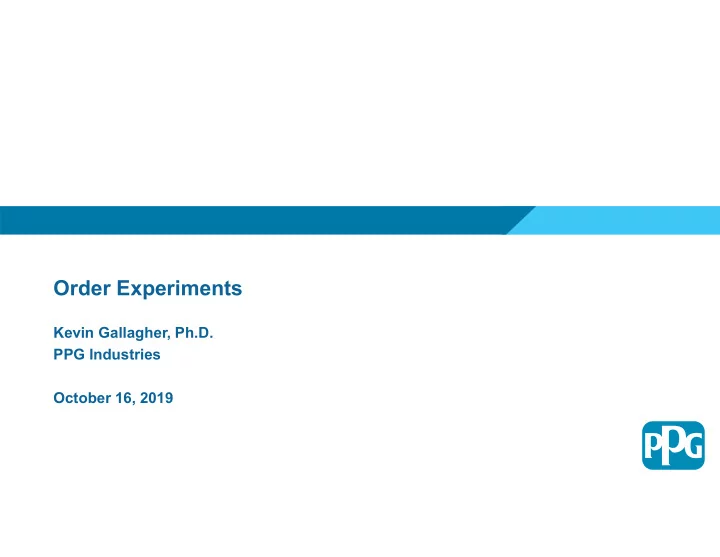

Order Experiments Kevin Gallagher, Ph.D. PPG Industries October 16, 2019
PPG: 46,600 employees protecting and beautifying our world A global maker A leader in all Headquartered Founded in 1883 Fortune 500: of paints, our markets: Ranked 182: in Pittsburgh, coatings, construction, Pennsylvania, with and specialty consumer products, operations in more materials industrial and than 70 countries transportation markets and aftermarkets
PPG Business Segments Architectural Coatings Automotive Coatings Packaging Coatings Industrial Coatings Aerospace Coatings Protective & Marine Coatings
PPG Coatings Innovation Center Allison Park, PA • 250+ researchers • synthesis chemists, formulators, analytical chemists, engineers • 600+ patents in past 10 years Fiat Sustainability Ford 2016 Excellence Award Award PPG is a coatings industry benchmark for innovation
Today’s Objectives: What is an Order Experiment? How do we design an Order Experiment? How should the experimental results be analyzed? What are the Factors and Factor Levels? 5
What is an Order Experiment? An Order experiment is one in which there are multiple process steps and the order in which the steps are performed is studied. Examples: • Knee brace - The order in which the straps are tightened • Survey - The order in which questions are asked • Coatings - The order in which multiple coating layers are applied • An important special case: Order-of-Addition - The order in which mixture ingredients are added • Paints Resins/Polymers Adhesives • Cosmetics Pesticides Foods 6
Lady Tasting Tea components, replications 7
What would be the “Full Factorial” equivalent of an Order Experiment? Full Factorial equivalent = all possible permutations Lady tasting tea: m = 2 components: Permutation 1: Milk Tea Permutation 2: Tea Milk Consider m = 3 components: Each of the 6 rows is a unique permutation of the three colored balls. 8
What are the factors and levels in an Order Experiment? Pairwise ordering Lady tasting tea: m = 2 components: Run Order f M<T factor : M before T Permutation 1: Milk Tea Milk = A 1 MT 1 Factor Level: Does Permutation 2: Tea Milk Tea = B M enter before T? 2 TM -1 1 = true, -1 = false Just one factor Consider m = 3 components: Run Order f R<G f R<B f G<B Run 1 RGB 1 1 ? 1 Red = R 2 RBG 1 1 ? Green = G 2 Blue = B 3 GRB -1 1 ? 3 4 GBR -1 -1 ? 4 5 BRG 1 -1 ? 5 6 BGR -1 -1 -1 6 9 3 factors
Order Experiments with All Possible Permutations (Full Factorial) As the number of components increases: number of number of number of pairwise ordering factors increase pairwise components, permutations, permeations increase factors, 𝑛 𝑛! � A new JMP Addin is available: � 1 - 1 All possible permutations 2 1 2 Pairwise ordering factors 3 3 6 4 6 24 Addin by Bradley Jones and Joseph Morgan 5 10 120 6 15 720 Fractional Experiments? 7 21 5,040 JMP Custom Design 8 28 40,320 Pairwise ordering factors Covariate Factors 10
Case Study: Automotive Clearcoat Component code (4, 24) (5, 15) (6, 24) shear thinning primary binder resin A 150 secondary binder resin B 100 Viscosity flow and leveling additive C rheology modifier #1 D 50 crosslinking resin E rheology modifier #2 F 0.1 1 10 100 1000 Shear Rate 11
Four Component Experiment 24 total permutations, 6 pairwise factors Experimental notation: Order (4, 24) Components ( m ) = 4, Runs (N) = 24 In general: Order ( m , N) The order column provides the instructions to how to run the experiment: The factor columns used to analyze Forward 2-stage stepwise regression Main effects first 2-factor interactions with heredity Order (4, 24).jmp 12
Case Study Example: Order (4, 24) 1) Stage 1: Use forward stepwise regression with only the “main effect” pairwise ordering factors 2) Stage 2: Use forward stepwise regression to add significant interactions between pairwise ordering factors involving only the important main effect factors (employing the strong heredity assumption) 13
Case Study Example: Order (4, 24) Best Y Primary before Secondary Binder Primary before Rheology Modifier To maximize the efficacy of the rheology modifier: • f A<D = false and f A<B = false • Thus, primary binder should be added after both the rheology modifier and secondary binder 14
Generating Optimal Fractions with JMP - Order Experiment 1) Use JMP Order of Addition addin 3) Add Covariate factors = pairwise ordering factors 4) Define model and number of runs 2) Custom Design 15
Evaluating Designs Order (4, 24) The 12-run experiment has: • Half the number of runs • Lower power to detect effects (increased chance to miss an effect – type II error) • More correlation of main Order (4, 12) effects with 2-factor interactions 16
Summary An Order experiment is one in which there are multiple process steps and the order in which the steps are performed is studied. • Order-of-Additions experiments are an important class of order experiments. • Pairwise order factors (e.g. B enters before C: B<C) are used to: • Analyze the experiment – treated as you would any other process variable • Find optimal subsets of the full permutation experiment to create manageable sized experiments • The factor levels are (1 = true; -1 = false) • The recommended analysis method is 2-stage forward stepwise regression: • Stage 1 – main effects; Stage 2 – interactions (limited to those with strong heredity) • Fractional subsets can be created by using the pairwise ordering factors as “covariate” variables with the custom design platform in JMP Forward thinking: • Mixture-Order experiments – ingredient amounts and order • Process-Order experiments – e.g. change process step order and reaction temperature. 17
18
Recommend
More recommend